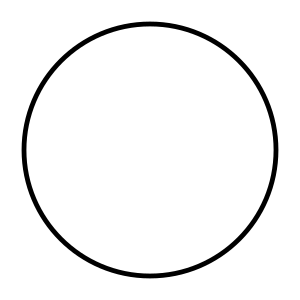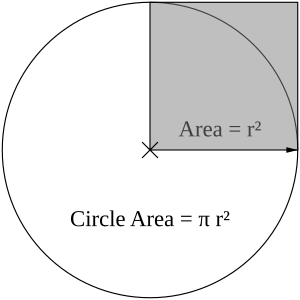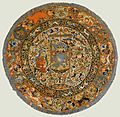Circle facts for kids
A circle is a round, two-dimensional shape. All points on the edge of the circle are at the same distance from the center.
The radius of a circle is a line from the centre of the circle to a point on the side. Mathematicians use the letter r for the length of a circle's radius. The centre of a circle is the point in the very middle. It is sometimes written as  .
.
The diameter (meaning "all the way across") of a circle is a straight line that goes from one side to the opposite and right through the centre of the circle. Mathematicians use the letter d for the length of this line. The diameter of a circle is equal to twice its radius (d equals 2 times r):
The circumference (meaning "all the way around") of a circle is the line that goes around the centre of the circle. Mathematicians use the letter C for the length of this line.
The number π (written as the Greek letter pi) is a very useful number. It is the length of the circumference divided by the length of the diameter (π equals C divided by d). As a fraction the number π is equal to about 22⁄7 or 335/113 (which is closer) and as a number it is about 3.1415926535.
 |
|
 |
 |
The area, A, inside a circle is equal to the radius multiplied by itself, then multiplied by π (A equals π times r times r).
Calculating π
π can be measured by drawing a large circle, then measuring its diameter (d) and circumference (C). This is because the circumference of a circle is always π times its diameter.
π can also be calculated by only using mathematical methods. Most methods used for calculating the value of π have desirable mathematical properties. However, they are hard to understand without knowing trigonometry and calculus. However, some methods are quite simple, such as this form of the Gregory-Leibniz series:
 .
.
While that series is easy to write and calculate, it is not easy to see why it equals π. A much easier way to approach is to draw an imaginary circle of radius r centered at the origin. Then any point (x,y) whose distance d from the origin is less than r, calculated by the Pythagorean theorem, will be inside the circle:
Finding a set of points inside the circle allows the circle's area A to be estimated, for example, by using integer coordinates for a big r. Since the area A of a circle is π times the radius squared, π can be approximated by using the following formula:
Related pages
Images for kids
-
Circles in an old Arabic astronomical drawing.
-
Tughrul Tower from inside
See also
 In Spanish: Círculo para niños
In Spanish: Círculo para niños









